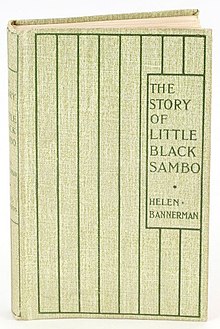The Story of Little Black Sambo

1st edition
|
|
| Author | Helen Bannerman |
|---|---|
| Illustrator | Helen Bannerman |
| Country | United Kingdom |
| Language | English |
| Genre | Children's literature |
| Publisher | Grant Richards, London |
|
Publication date
|
1899 |
| Media type | |
The Story of Little Black Sambo is a children's book written and illustrated by Scottish author Helen Bannerman, and first published by Grant Richards in October 1899 as one in a series of small-format books called The Dumpy Books for Children. The story was a children's favorite for more than half a century.
However, it would become an object of allegations of racism in the mid-20th century. Critics of the time observed that Bannerman presents one of the first black heroes in children's literature and regarded the book as positively portraying black characters in both the text and pictures, especially in comparison to the more negative books of that era that depicted blacks as simple and uncivilized. Both text and illustrations have undergone considerable revision since.
Sambo is a South Indian boy who lives with his father and mother, named Black Jumbo and Black Mumbo, respectively. While out walking, Sambo encounters four hungry tigers, and surrenders his colourful new clothes, shoes, and umbrella so they will not eat him. The tigers are vain and each thinks he is better dressed than the others. They chase each other around a tree until they are reduced to a pool of ghee (clarified butter). Sambo then recovers his clothes and collects the ghee, which his mother uses to make pancakes.
The book's original illustrations were done by the author and simple in style, typical of most children's books, and depicted Sambo as a Southern Indian or Tamil child. The book has thematic similarities to Rudyard Kipling's The Jungle Book, published in 1894, which had far more sophisticated illustrations. However, Little Black Sambo's success led to many counterfeit, inexpensive, widely available versions that incorporated popular stereotypes of "black" peoples. For example, in 1908 John R. Neill, best known for his illustration of the Oz books by L. Frank Baum, illustrated an edition of Bannerman's story. In 1932 Langston Hughes criticised Little Black Sambo as a typical "pickaninny" storybook which was hurtful to black children, and gradually the book disappeared from lists of recommended stories for children.
In 1942, Saalfield Publishing Company released a version of Little Black Sambo illustrated by Ethel Hays. In 1943, Julian Wehr created an animated version. During the mid-20th century, however, some American editions of the story, including a 1950 audio version on Peter Pan Records, changed the title to the racially neutral Little Brave Sambo.
...
Wikipedia
